Text
Hello. It’s been awhile.. and I’m finally writing again
Hereby lies my overflowing thoughts of my journey in my 3rd year of studying composition & arranging at Lasalle College of the Arts. Hereby i present to you my logbook. I hope it’s interesting to read..
SEMESTER 1
WEEK 2 || Monday, 7th September 2020
note: Lesson 1 started at Week 2 in 2020.
Topics:
Review of Harmonic Landscape
Advanced Modulation
HARMONIC VOCABULARY
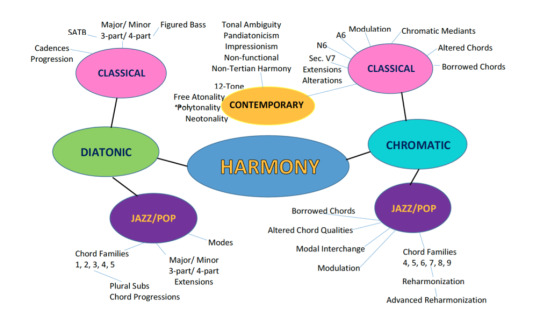
(Belinda Foo. Lasalle College of the Arts 2020)
ADVANCED MODULATION
refer to Max Reger’s text on Modulation
Some key concepts;
No Enharmonics
All modulations approached via cadence-like progressions
Observations;
The modulations are ‘logical’ and can be accountable via tonal relationships
All modulations are arrived at cadentially: IV – V – I, II – V – I, bII – Ic – V – I
It is easier to work out the modulations ‘backwards’ from the dominant of the new key
Relationships between Keys
Pivot chords
Borrowed chords
Neapolitan 6th chords (especially for remote modulations)
Dorian 6th chords (E.g. D major triad in A minor)
2nd super-dominant (E.g. D major triad in C Major)
REVIEW ADVANCED REHARM
Review Menu of Chord Choices
Using Outer Line Movement: Directional interaction between Melody and Bass line
Contrary Motion
Parallel Motion
Chromatic Movement
Tonal Movement
Tritone Movement
Pedal Point
Free Bassline
Contrary Motion

Parallelism
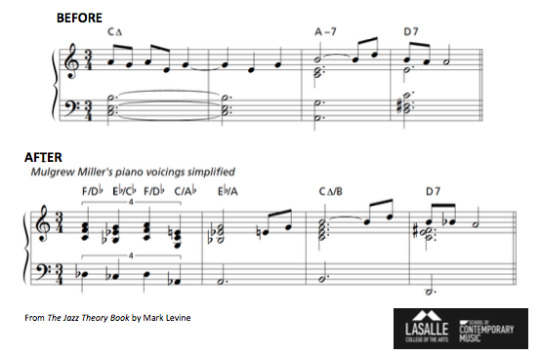
Chromatic Movement

Tonal Movement
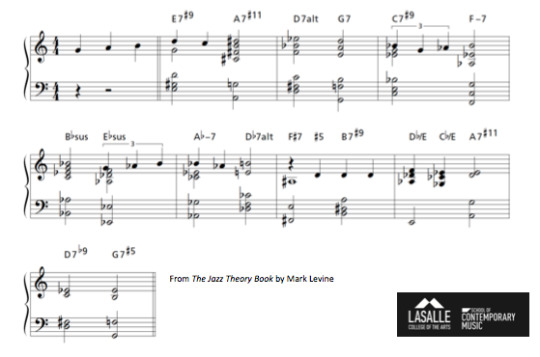
Tritone Movement


Pedal Point
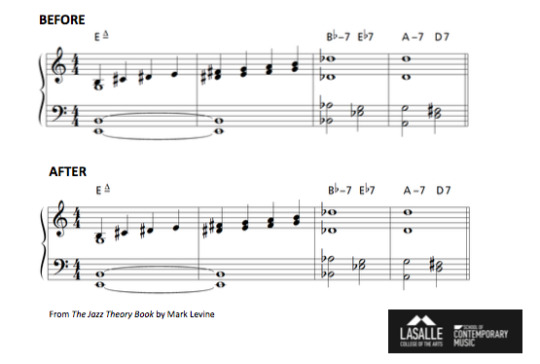
Free Bass line
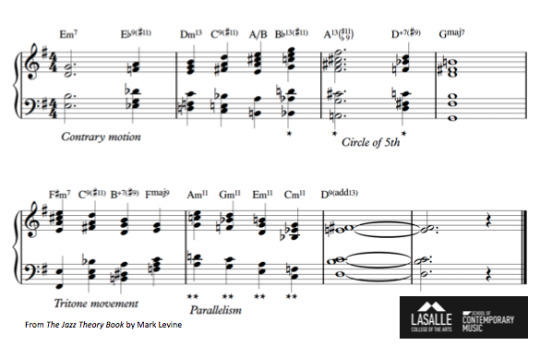
Use of Polychords
C Major triad over Bb7
F# Major triad over A7
Bb Major triad over D7

Use of Minor 11th Shapes:
Open 4th at the bottom
Triad (2nd inversion) at the top

—————————————————————————————
WEEK 3 || Monday, 14th September 2020
In week 2, Belinda discussed the same topics from Week 1 because we had not yet covered everything last week. My summary from this week is concluded in week 1 as it is also pretty much the same from last week. Belinda also further talked about Max Reger’s techniques.
Topics:
Review of Harmonic Landscape
Advanced Modulation
—————————————————————————————
WEEK 4 || Monday, 21st September 2020
In week 3, Belinda further talked about Max Reger’s modulation again. The summary for this one is also included in my week’s 1 summary. Other than that we discussed about Romantic and Late-Romantic music, Wagner’s Lohengrin, and writing for strings.
Topics:
Max Reger Modulation Review
Romantic & Late-Romantic Orchestration
Analysis of Wagner’s Lohengrin
Writing for Strings
ROMANTIC MUSIC PERIOD
basic information:
From about 1830 to 1900
Characteristics: expressive, expansive, virtuosic, inspired by art, literature
New forms beyond the Classical forms, such as: rhapsody, arabesque, song cycle, nocturne and programmatic music
Greater Chromaticism
Extended melodic lines, themes
Romantic Composers
Berlioz, Hector
Brahms, Johanne
Bruckner, Anton
Chopin, Frédéric
Dvorák, Anton
Grieg, Edvard
Mahler, Gustav
Tchaikovsky, Peter
Strauss, Richard
Wagner, Richard
Relevance of Romantic Music Today
Melodies and Harmonies still used in Film & Animation music
Leitmotif: a theme associated with a character, place or idea
Orchestration: Romantic Orchestra & Orchestral techniques
COMPOSING FOR STRINGS
Characteristics of the Strings Family;
Homogenous timbre throughout the family
Virtually tireless for both player and listener
Flexible, versatile in terms of register and ability
Writing for Strings Masterclass:
link: https://www.youtube.com/watch?v=yST6mS8W1f8&ab_channel=JeffPifher
personal note:
This was actually a homework from previous week from Belinda, and i watched the video beforehand. There were some key takeaways to make writing for strings more interesting like (which are actually unbelievably so simple) ;
- “know what to look for” — pay attention to your melody, style, phrasing
- playing with texture (e.g. one line playing staccato, another line playing legato/long lines)
- accents!!! — articulation is key!!!
The Strings Choir as:
Foreground
Middleground
Background
Homophonic Writing
Accompanying Choir
Contrapuntal Textures
Special Effects and other 20th Century devices
String Section Sizes

General String Writing Tips
Divisi: divides the section, used to add/ complete harmony. Div a 2, Div a 3, Div a 4 (not common). Not a good idea to divisi violas if they are less than 8 players (6 players minimum)
Double stops: most commonly used to add harmony part. Stick to slow moving passages. Check that the double stops are feasible on the instrument.
Pizzicato: Best kept to the lower 3 strings
Octave combinations: It is common practice to double very high violin lines (Violin 1) an octave lower (Violin 2) to lend the former support.
Bowing Effects
Belinda asked us to refer to this video, which I also watched before the class as it was part of our homework from last week.
link: https://www.youtube.com/watch?v=cEBN2UkJavk&ab_channel=VIOLINLOUNGE byViolinistZlata
ANALYSE WAGNER’S LOHENGRIN PRELUDE 1
note;
during this analysis, our main focus was the string writing, string choir: homophonic writing primary line against accompaniment
link: https://www.youtube.com/watch?v=gT1AfIUgO88&ab_channel=ClassicalMusicScores
—————————————————————————————
WEEK 5 || Monday, 28th September 2020
Topics:
Max Reger Modulation Review
Writing for Woodwind
Analysis of Wagner’s Rienzi
MAX REGER MODULATION REVIEW
This week, Belinda reviewed about the Max Reger modulation. The summary is pretty much the same with the previous weeks we had it.
WRITING FOR WINDS
Characteristics of the Wind Family
Less homogenous in sound (unlike the Strings)
Single reed and double reed timbres differ
Wind players need to take breath
Some Interesting Effects
Double-tongueing/ Triple tonguing
Harmonics - The pitch of the harmonic sounds exactly as it is notated
Fluttertongue - Flautists flutter their tongues to create a “frrr,frrr” sound
personal note;
because of the lessons and workshops I had from Felix’s class (Specialized Ensemble Workshop), these effects were no strangers to me and I am quite familiar with it. I have also used these effects in my composition (mainly in his class). But this lesson was a good refresher to me.
Common Functions
Harmonic background - Homophonic wind writing
Solo passages - Choice of timbre/colours
Contrasting colors - To repeat or echo; create relief
Double other instruments - add richness, warmth; brighten up
Contrapuntal Writing
The unique color of each wind instrument makes for ideal contrapuntal writing
Refer to Britten’s The Young Person’s Guide to the Orchestra, Fugue, mm 1-55
Refer to Stravinsky’s Rite of Spring, “L’Adoration de la terre” mm 40-60.
Special Effects and other 20th Century devices
Belinda showed us some pieces that has examples of special effects. The pieces we discussed were;
1. Penderecki, Dies Irae “Apocalypsis” mm 2-4
Winds first play the highest pitch they are able to produce. Then they trill on the specified notes until the end of the dark line with arrow.
2. Stachowski, Irisation for Orchestra, third movement, mm. 79-83
The composer asks the winds to remove their mouthpieces from their instruments and “play through them.
ANALYSES OF WAGNER’S RIENZI
note:
during this analysis, our main focus was the woodwind writing, homophonic writing, choice of color,relief, highlights, adding warmth, and color
—————————————————————————————
WEEK 6 || Monday, 5th October 2020
Topics:
Writing for Brass
Analysis of Wagner: The Flying Dutchman
WRITING FOR BRASS
Characteristics of the Brass Family
Most powerful sound resource in the orchestra
Not as homogenous in sound as the strings although horns and trombones can blend fairly well
Not’ tireless’ on players and listeners — the brass sound is an imposing one and players need to breathe
Common Functions
Homophonic Unit
Pay attention to voicing, spacing, voice-leading and doubling
Refer to overtone series
Strengten and clarify harmony
Reinforcing harmony played by another choir
As a pedal
Harmonic ‘glue’, background line
State a melody
Choice of timbre, dynamics
Combinations
Double other instrument(s)
To add colour
add weight, power
Build Climaxes
Hold back first, save the colour for climactic event Contrapuntal voice
Use instruments in their best register — clarity go line and balance
Pay attention to timbral differences and articulation
refer to Stravinsky’s J.S Bach Choral Variations, Var. IV, mm. 1-6
Special Effects in Brass
refer to “Contemporary French Horn Techniques - Guide for Composers”
link(s):
https://youtu.be/_FPDrQzRE3o
https://youtu.be/-IwXEyr4uV8
https://youtu.be/qQ1oe3YSqsY
ANALYSIS OF WAGNER’S “THE FLYING DUTCHMAN”
note:
In this analysis, our main focus was the brass writing, choice of color, and orchestral combinations.
another note (not important); everytime i hear the word Flying Dutchman, it reminds me of the movie Spongebob Squarepants :))))). The Flying Dutchman is the ghost that Spongebob and citizen of bikini bottoms most feared of
—————————————————————————————
WEEK 7 || Monday, 12th October 2020
Topics:
Motivic/Thematic Development
Orchestral Devices
Analysis of Holst’s Mats, Mercury, Venus
MOTIVIC DEVELOPMENT
Repetition
Sequence
Changing intervals
Fragmentation
Extension
Inversion
Changing the rhythm
Decorated repetition
Changing order of notes
Augmentation
Diminution
Contraction
Expansion
personal note:
Belinda showed us examples (played it on her keyboard) of motivic development by playing a short motif and expand it by using the devices above. It is such a simple idea yet so useful and i foresee myself using these techniques many times because of the very little amount of time i’ll be having to write for my recital. a.k.a squeezing juice out of my brain!!!
THINKING ORCHESTRALLY
Basic Concepts
Balance
Sonority
Unity, Variety
Tone/ Timbral colour
Clarity, Brilliance
Expressiveness
Orchestral Textures
Orchestral Unison
Melody and Accompaniment
Primary and Secondary Element(s)—Melody, secondary line(s), accompaniment
Part Writing
Isolated Chords
Complex Texture
ORCHESTRAL DEVICES
String Quartet & Wind Quintet
Within Family timbres
Solo feature
Combination of timbres
Tutti unison
String devices; bowing techniques (detaché, legato, marcato, staccato, spiccato, au talon, Punta d’arco), Pizzicato, tremolo, col-legno, sul ponticello, glissandi/portamenti, harmonics
Wind devices; Double-triple tonguing, flutter tonguing, harmonics, slap-tongue
Brass devices; mutes, stopped, double-triple tonguing, glissandi, bells up (horns)
Percussion; Types of Percussion— pitched, unpitched, Metal, Wood, Non-metal, Membranous, Keyboard
ANALYSES OF HOLST’S “MARS”, “MERCURY, and “VENUS”
note;
during this analysis, we focused on the choice of color, orchestral combinations, and motivic/thematic development
personal note; i love love love uncle Holst so much. I wish i wrote his pieces. Some of his pieces from The Planets series also has become my inspirations in writing my recital pieces!
—————————————————————————————
WEEK 8 || Monday, 19th October 2020
Topics:
Review Compositional Devices
Analysis of Holst’s Mercury, Venus, Jupiter, and Uranus
COMPOSITIONAL DEVICES
remember remember remember this!
Common Practice Tonal Centers — Major and Minor
Chord Extensions — 9ths, 11ths, and alterations
Added note chords
Chromaticism and Tonal Ambiguity
Meter-Mixed and Asymmetrics Meter
Modes and other Scale sources, including Synthetic scales
Pandiatonicism
Polyharmony—Polytonality and Polychords
Non-Tertian Harmony — Quartal and Quintal
Scandal Chords — clusters
Parallelism
12-tone Technique and Serialism
Limited Composition—based on intervals
Hexachord Writing
Unrelated Triads
Neotonality
Mirror Writing
Harmonic Direction; Progression, cadential services
Harmonic Synthesis
Indeterminate Procedures
NEOTONALITY
basic information;
Tonality that is not based on any particular diatonic system nor functional harmony (Common Practice Period)
Features non-traditional concepts such as tonal assertion or contrapuntal movement around a tonal centre (which may shift).
Combining the features of Common Practice Period tonality with 20th Century tonal ambiguity and atonal characteristics
Neo-tonal Composers
Paul Hindemith
William Schuman
Roy Harris
Samuela Barber
Vaughn Williams
Sergei Prokofiev
Igor Stravinsky (Neo-Classical pieces)
ANALYSIS OF HOLST’S MERCURY, VENUS, JUPITER & URANUS
i love holst’s piece because it sounds like a film score!
Mercury
The Winged Messenger
Energetic, momentum
Changing tonalities-darting from key to key
Rhythmic & Metric ambiguity
Venus
Bringer of Peace
Woodwinds — overlapping winds, tertian harmonies, sweet
Twinkling effect — 2 harps, glockenspiel
Lines —lower strings
Jupiter
Jollity
Full of beautiful themes, melodies
Use of Timpani
Syncopation
Uranus
Rotates on its side (axis is different from other planets
‘Lop-sided feel’
Strong motif: G-Eb-A-B
personal note:
my favorite is probably the Jupiter piece. It has also become an inspiration for my recital pieces. The sounding-like-film also very much suits my style!
—————————————————————————————
WEEK 9 || Monday, 26th October 2020
Topics:
Review Compositional Devices Pt.4
NEW: Media Music
REVIEW COMPOSITIONAL DEVICES
My summary would be pretty much the same from last week
MEDIA MUSIC
basic information:
Music that is written for film, TV, animation, games, commercials, web applications with the intention of enhancing the production or product.
Practicalities to Note
Specificity of usage
Duration, mixes
Open-ended (looped), Closed-fixed duration
Style, Concept
Target Audience
Functions of music in Media
Commenting
Illustrating Movement
Enhancing Momentum
Create Atmosphere
Portray Emotions
Social/Cultural/Geographical references
Time/Period references
Connects scenes and montages
Alternate the perception of time
Imply a sense of space
Create unreal situations
Create contradictions
Physiological Conditioning
Imply size relationships
—————————————————————————————
WEEK 10 || Monday, 9th November 2020
Topics:
Serial & Atonal Counterpoint
Counterpoint in Hindemith, Bartok, and Stravinsky
Chapter 27 &28 Harold Owen, Counterpoint
SERIAL & ATONAL COUNTERPOINT
during this discussion Belinda showed us examples from;
Schoenberg, No.4 from Five Piano Pieces OP. 23
Webern, Variations for Piano Op. 27, Movement II
Things to pay attention to were;
Texture
Cohesion
Use of Dissonance & Consonance
Temporal Elements,Rhythm, Pulse, Meter
Canonic Qualities
HINDEMITH, BARTOK, AND STRAVINSKY COUNTERPOINT
Belinda showed us examples from these pieces;
Hindemith, Fuga Quarta in A, Ludus Tonalis
Bartok, Theme and Variation from Mikrokosmos, Book IV
Stravinsky, Great Chorale from L’Histoire du Soldat
we also discussed about the things noted below;
Hindemith
Compare the melodic style of hindemith’s fugue with Schoenbrg’s piece
Describe the vertical sonorities, cadences, and treatment of the major triad
Describe the temporal aspects in Hindemith’s fugue and compare them with Schoenberg and Webern
Bartok
What is the tonal centre of this piece?
Describe the melody in this example
What are the intervallic relationships?
Explain the significance of ‘Theme & Inversion’
How are the parts related and yet maintain their independence?
Discuss the rhythmic treatment
Stravinsky
How does the ‘Great Chorale’ resemble a Bach Chorale?
What key is this chorale in? Describe the cadences.
There is liberal use of chromaticism, yet the voice-leading is diatonic. Explain this.
There are triads in the harmony. Discuss how they are used here in comparison to music of the Common Practice Period.
—————————————————————————————
WEEK 11 || Monday, 16th November 2020
Topics:
Review Series & Atonal Counterpoint
Passacaglia writing
Creating Harmonic & Textural Worlds
REVIEW SERIES & ATONAL COUNTERPOINT
Discussed the same thing from last week, and Belinda discussed the things she has not yet covered, making the topic more in-depth. My summary for this is the same from last week.
PASSACAGLIA WRITING
What is Passacaglia form?
Passagcalia is a musical form of continuous variation in triple time. It was a courtly dance that originated in Spain in the 17th Century.
The passagcalia usually begins with an ostinato in the bass, but is also found in other voices.
How to write a Passacaglia?
Begin with a ’tonal’ line that will work well as a repeated pattern
Variation is created as other lines are layered over/ under this repeated pattern
This initial theme can be sequenced, but it should not be modified too much
The initial theme should always be present in at least one of the voices
Famous Passacaglias include:
Bach- Passacaglia and Fugue in C minor for Organ, BWV 582
Ravel- Piano Trio in A minor, III. Passacaille
Copland- Passagcalia for Piano (1921-22)
Hindemith- Passagcalia, Noblissima Visione Suite
William Schuman- Symphony No. 3
Things discussed;
How is the initial theme repeated, varied?
How are layers added?
How is the theme sequenced?
How are dissonances and consonances manipulated?
Observe density and contour
Observe textural changes
—————————————————————————————
WEEK 12 || Monday, 23rd November 2020
Topics:
CONSULTATION FOR HALF RECITAL
General Types of Musical Material
CONSULTATION FOR HALF RECITAL
For my consultation, I showed Belinda my first draft of my first piece from my recital, titled “The Bushfire, The Flood, and The Virus”
GENERAL TYPES OF MUSICAL MATERIAL
Unaccompanied melody
Unified harmony
Composite harmony
Imitative counterpoint
Similar Counterpoint
Contrasted Counterpoint
Composite musical material
Unaccompanied Melody
Solo
Doubled Unison
Doubled at the Octave(s)
Tutti Unison
Unified Harmony
All parts move in the same rhythm
May be minor, incidental rhythmic differences
Uniform tone-quality
example;
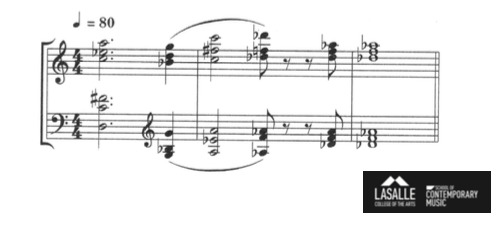
with some minor, incidental rhythmic differences;
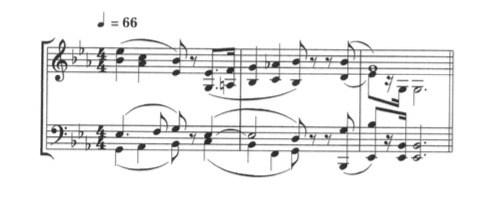
Composite Harmony
2 or more chordal components are layered, each harmonically completely alone
May be treated as harmonically unified or composite
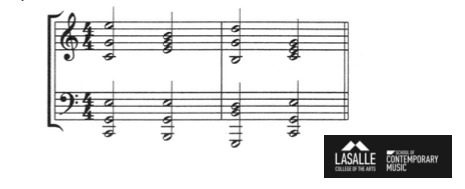
a large vertical distance between the 2 shapes divides it into 2 parts. The harmonic effect is divisive.

The contrary motion of 2 simultaneous chordal units: produces the effect 2 constituent harmonic units
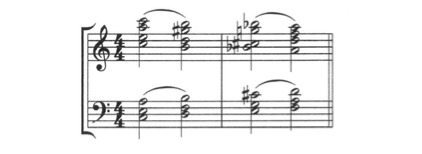
The presence of 2 or more chordal units, with independent rhythms

The effect of unified or divisive harmony depends on these factors:
Tone-quality: the use of a single tone-quality or similar tone-qualities will produce a unified effect
Direction: parallel movements tend to be more unifying than contrary motion
Common rhythms are unifying
Large distances between harmonic units have a divisive effect
Imitative Counterpoint
This involves canonic situations.
To bring out the relationship of imitative parts, one tone-quality should be used.
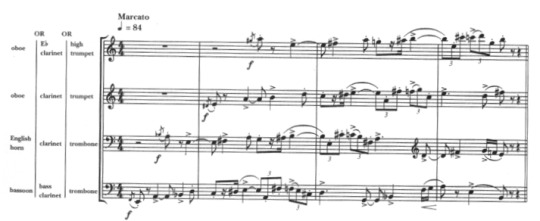
‘Similar’ Counterpoint
This is non-canonic counterpoint.
The parts are related by common rhythmic and intervallic ingredients
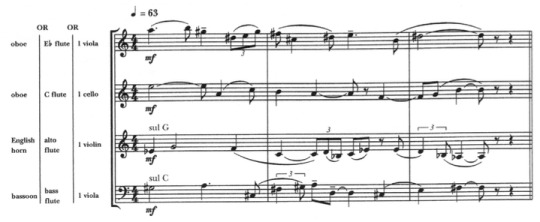
Contrasted Counterpoint
The lines are have noticeable differences in intervals and rhythms
The differences may be accentuated with the use of different timbres

Composite Music Material
A melody with its own rhythm, accompanied by unified harmony in another rhythm, plus composite harmonic interjections:

next example; Imitative counterpoint (piccolo & clarinet) superimposed on unified harmony (strings) in contrasted rhythm, plus a bass line (tuba) in a different rhythm.
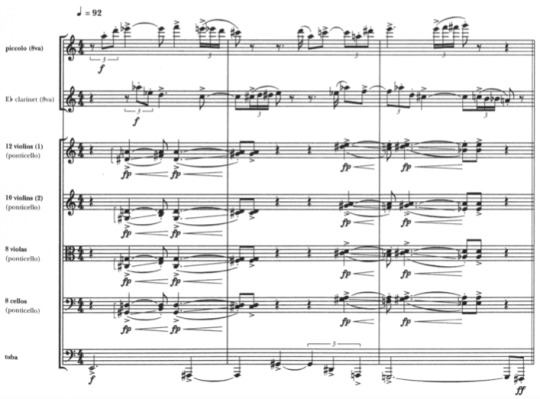
Next example: Composite harmony- violins & violas in 1st group, cellos & basses in 2nd group- enclosing a 2-part ‘similar’counterpoint (2 horns), whose rhythm is different from the harmony.
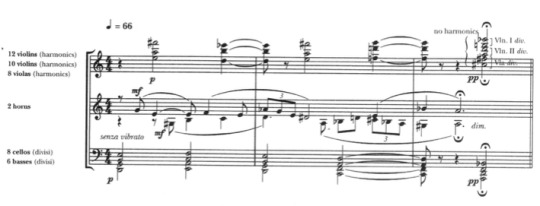
—————————————————————————————
HALF RECITAL
for my Half recital, i submitted 3 pieces out of 4. They were the;
The Bushfire, The Flood, and The Virus (2′20″)
Purple Pinkish Cotton Candy Sky (1′57″)
Full Moon (2′32″)
———————————————————————————
———————————————————————————
———————————————————————————
SEMESTER 2
WEEK 1 || Monday, 18th of January 2021
Topics:
Review semester 1
Scoring for Film, Animation, and Media
Review Semester 1
It was finally the first day of school again! at the beginning of the class, Belinda asked about what we had been doing during the holiday. I personally spent my holiday working on writing 3 shanghai jazz songs for a short film. In addition, I was arranging for lasalle’s Composer’s Concert 2021. Planning the date, concept, musicians (for my own band), and composers who are interested to showcase their pieces at the concert. —— BACK TO THE TOPIC —— Belinda mentioned that she was surprised to hear some of the works from half recital which me and my classmates did and we were happy to hear that! afterwards, the lesson started.
Scoring for Film, Animation, and Media
Finally....SCORING. One of my biggest interest in music is Film Scores. And to be honest with you, the reason i went to Lasalle and took Composition & Arranging as my stream was because i wanted to be a Film Composer. I’ve always dreamed of being one ever since i was young. So, this topic really interest me indeed. I had been looking forward for Belinda to teach this ever since the start of my day 1 studying at lasalle. “Finally... i thought.”
Here are a little summary from it;
Film Scoring — The People
The Producer: responsible for developing and nurturing the project from beginning to end. He hires the proper people, raises money, seems the film. His role is varied and straddles the administrative, financial, and creative.
The Director: responsible for envisioning and approving creative decisions. He wants the score to reflect and enhance the idea of what the film is about.
The Executive Producer: Usually the CEO of the production company. He is not in charge of the daily processes but will exercise final control over all the elements—business and creative.
The Editor: works with the director and cuts, edits his footage into a story flow. He is likely to have a good idea of how the music should fit the footage and can be an excellent liaison between composer and director
The Music Supervisor: handles the administrative part (and sometimes creative) of the music for the film/ TV program. He works with budgets, negotiated deals, hires contractors, arranges recording sessions, etc.
Film Scoring — The Screening
Go in with a notepad
Concentrate on the big picture—the overall emotional effect, the film’s effectiveness
First impressions matter—note them
Get a sense of the mood, feeling
Do not do any spotting yet
Film Scoring — Rough Cut
Establish a concept for the score
Demonstrate that concept the composer
Whilst helpful in providing the composer with a clear musical direction, they can also be a bane when the director is so used to the music that anything else will not satisfy him
Film Scoring — Style & Genre
In every style, genre of film, there is an appropriate response, an expectation, a vocabulary. These expectations are based on a precedent, a thorough study of classic films in a particular genre is essential to successful scoring. It’s not about imitation but about knowing the language and eliciting an appropriate response/reaction.
Film Scoring — Main Genres
Action
Adventure
Animation
Comedy
Crime & Gangster
Drama
Epic/Historical
Fantasy
Horror
Musicals/Dance
Science Fiction (Sci-Fi)
War
Westerns
Film Scoring — The Concept
The concept is the heart of the score. It can be discussed in terms of musical style and will form the basis of the thematic material of the film score. The composers needs to understand the central character and motivations.
There is also another dimension to scoring the character apart from scoring his/her personality, and that is, getting inside the character’s head. That dimension can chance from scene to scene, moment to moment.
On my personal note; i went to surf the internet and read more about this. After reading more about film music, i discovered that film theorists often categorize film music as diegetic or non-diegetic. Diegetic music, the music we perceive the characters can hear, is part of the story world. Meanwhile, Non-Diegetic, also called as commentary or nonliteral sound, is any sounds that does not originate from within the film’s world. Non-Diegetic music (such as a film’s title theme) narrates the film from “outside” the story world and is only audible to the audience. When Belinda mentioned about the music getting inside the character’s head, it can also be referred as diegetic music.
Back to the topic, to summarize, when talking about the concept of the film, it’s important for us the composer to know what the film is really about. Explore the characters and their themes. Often, films will have more than one dramatic theme; a personal theme and a larger overview sort of theme.
another thing to take note is that musical genres/styles are often part of a score and it is IMPORTANT to stay CONSISTENT to those styles throughout the film. Composite style (where several different stylistic elements are fused together) are also permissible but think of the appropriateness of the music to fit what is happening on the screen.
Film Scoring — The Tone
Tone refers to the attitude of the dramatic work. Whether is it dark or uplifting, etc. The composer needs to get a clear direction of tone in order to ‘assist in the storytelling’.
example: “Raiders of the Lost Ark” is a movie whose tone changes drastically from moment to moment: from humor to terror, from impending doom to a swashbuckling escape.
Checklist:
Overall dramatic theme
The central character
other themes
Time (period) / Place / Ethnic flavor
Instrumental Palette
Musical Style
Combination of styles, colors?
personal side note:
Perhaps what i understood about this is that the tone of the music is something that everything revolves around with, and in order to set the tone of the music, we need to understand the concept of the film well enough. Understanding the character, mood, and genre.
The tone can be set by things like our orchestration, instrumentation color palette (timbre), and also the techniques we use to compose like harmonic language and texture.
—————————————————————————————
WEEK 2 || Monday, 25th of January 2021
In week 2, Belinda resumed the topics from week 1. She also discussed more deeply about it. In this week, she also talked about the devices/musical techniques that we should considerate when scoring for a film.
Topics:
Scoring for Film, Animation, and Media (Part 2)
FILM SCORING — ETHNIC, PERIOD
When scoring for films with ethnic/period character, the composer needs to decide if he/she will score totally in that style, just flavored by those musical elements or not influenced by that time and place and all.
In some instances, musicological accuracy is necessary, but most situations call for a combination-approach: ethnic/historical accuracy and other harmonic/melodic language to score the drama and action.
Things to consider:
The film’s point of view
Scales, motifs, folk tunes, harmonies of that ethnicity/ time/ place
Rhythms of that ethnicity/ time / place
Instruments
There us a fine line between authenticity and stating the obvious. Avoid music clichés and other tires and overused references.
FILM SCORING — PLAYING THE DRAMA
Your audience has expectations: as a composer, you need to know what they are before you can use those expectations as tools for manipulation.
You can surprise your audience, but never betray them. Their expectations are tied closely to the function of the score and the style of the movie. The score must do what the audience expects it to do- excite them, lift them up, tug at their heart strings, make them curious, etc.
The composer knows the ending but the audience doesn’t, so it’s really important that the music never “spoils” it or gives too much away.
Whose point of view are you playing? The audience or the character?
If you are playing the audience’s POV, you’re scoring their emotional reaction. If you’re playing the character, then you’re scoring the emotional/ mental state or action that the character is in or is doing.
Main Title: The main title establishes the overall tone and setting for the movie and primes the audience’s expectations.
Dialogue: Underscoring dialogue is tricky as the composer needs to ensure that the dialogue can always be heard and understood. Where the lips can be seen, comprehensibility is easier as the audience can lip read. In instances where the lips cannot be seen, extra care needs to be exercised.
notes on Dialogue:
In general, smooth musical textures are less intrusive. Also, try to keep out of the speaking range.
Stay away from accents and distinct solo lines: allow the spoken line to be the ‘soloist’
Don’t overwrite. It’s an underscore.
MUSIC AND ITS ASSOCIATIONS
Many styles of music already have their visual and emotional associations: Gritty Jazz puts us in a big city, Gregorian chant brings us into a monastery. Use the power of musical associations to get the audience in the right place, in the right state.
for example: the film “Out of Africa” scored by John Barry has the genre of classic romance. The score is associated to the romance rather than about the period film set in Africa.
Musical Points of View
Getting inside the character
De-emphasizing the scene
Juxtaposition—playing against the scene
The minimalist approach (ex: “American Beauty” plastic bag scene by Thomas Newman
Silence
Highlighting, accenting the drama
MUSICAL CONSIDERATIONS
Now that you have a concept for the score, the next step is to translate that concept into musical terms.
The basic elements to consider are melody, harmony, rhythm, and instrumental color.
Unity and Variety
Strong scores strike a fine balance between repetition (recognition) and variety. Repetition in music can help to develop emotional power through the cumulative reactions of the audience to the repetition of a theme. With repetition, the association between the music and the characters/ situation becomes stronger.
The same theme can also be modified/ varied to suit a different setting.
Tempo/Pulse
This is the first task of the composer: to determine the pace of the scene/cue
Checklist:
Does the tempo feel emotionally compatible with the scene?
Does it provide forward motion?
Will it provide too much forward motion?
Is this a comfortable tempo for dialogue?
If the cue calls for tension, play a low repeated note with basic pulse and check if there is dramatic build-up
There are cues/scenes that require a change in pulse and tempo. The composer will need to plot a variable click in those instances.
Hitting/Catching the action
Unless the composer is scoring for cartoon/ animation, he/she will not be catching all the action. This is also known as Mickey-mousing.
The average score catches less and more subtly and often plays through the scene. Composers will score the emotional shifts in the scene, usually subtly, through entry of themes, change in colour, rhythm etc...
Composers need to analyze the scene by taking note of the shifts of emotional emphasis, shifts in action, shifts in camera angles, editorial cuts.
Beginning the Sketch:
Plot out the shifts on your sequence. Note the timings
Decide on the tempo and tempo changes. Plot the click and adjust meters accordingly.
Compose the thematic material for the cue.
Plot it into the sequence. (It may not appear at the beginning of the cue)
Check to see if the entry of the theme is compatible with the visual and shift it/ adjust it until it fits.
Write around the theme- into its entry and after it is stated.
Using the 4 basic elements of melody, harmony, rhythm and instrumental colour, finish writing the cue.
The motif is a powerful compositional tool that composers have used throughout the centuries. The motif allows the composer to write with unity and leaves him/her room for variety.
A strong motif is the key to a strong score.
Examples of strings motifs;
Beethoven’s 5th Symphony
John William’s Jaws
John Barry James Bond- Octopussy
Nino Rota Godfather- Love Theme
John Williams- Return of the Jedi- Darth Vader Theme
Bill Conti- Rocky Fanfare
HARMONIC CONSIDERATIONS
Harmonic language is the emotional palette that composers use to elicit a desired response from the audience.
Triadic shapes and traditional progressions elicit different emotions from atonal and dissonant sources. Composers need to pay attention to the tension or placidity of their harmonic choices and combinations.
Choices:
Diatonic Harmony and Chromatic Harmony
Modal Harmony
Pandiatonicism
Quartal/ Quintal harmony
Exotic/ Synthesized scales
Limited Composition, Hexachords
Polytonality
Atonality/ Serialism
Harmonic Devices:
Vertical Structures (Homophony)
Linear writing (contrapuntal writing)
Pedal points
Ostinato
Complex Texture
—————————————————————————————
WEEK 3 || Monday, 1st of February 2021
Topics:
Influence of Great Composers
17 Functions of Music in Film
INFLUENCE OF GREAT COMPOSERS
In week 3, Belinda showed us some of the most influential composers in the past that also affects film composers nowadays. Some of the composers and their pieces she discussed in the class were;
Stravinsky - “Rite of Spring”
Bartok - “Music for String instruments, Percussion and Celesta”
Orff - “Carmina Burana”
Brahms - ”Symphony No. 3, 3rd movement”
In the class we discussed and analysed about the musical devices that are happening in the pieces. like;
The melodies, lines, motives and identity, motivic development
The harmonies, harmonic devices; harmonic language as an emotional device
Rhythmic devices; rhythm as a thematic idea, uneven meter, polyrhythms
Orchestral devices; orchestration as a tool for characterization/setting, orchestration as an emotional device.
17 FUNCTIONS OF MUSIC IN FILM
1. Commenting
This is a function that shouldn’t be overdone. Music can put a judgement on certain movie scenes, it can state that a certain battle scene is heroic, a certain dialogue is sad etc.
In the early days of film music, the function of the music was most of the time to comment on the images. Nowadays we perceive this as an annoying redundancy most of the time but used cleverly it will help push the audience into the right direction.
2. Illustrating Movement
Another function that feels rather old fashioned and comedy. Accenting with the music every movement seen on screen is so-called mickey-mousing (coming from a scoring technique that was often used in Mickey Mouse cartoons). Hearing xylophone “plings” when someone raises his eyebrow etc. feels very cartoony however it can be great in slapstick moments and when done well even in dramatic situations.
3. Creating Plot Relationships
The use of so-called leitmotifs has been established by Richard Wagner in the opera and has often be used in film context since the early days of film music. Giving certain characters/situations/places thematic identities helps to connect certain plot points together.
When the villain gets a theme and later we hear that theme again when somebody talks about a “stranger” we get a very clear hint of who that stranger might be. It doesn’t need to be that obvious for leitmotifs to work, of course. However, be warned to not overdo that technique. Not every supporting role needs a motif/theme and it can quickly feel very old fashioned when using this method extensively.
4. Creating Atmosphere
This is one of the strongest function of music in the movies. It can set the tone of the movie. Just by the way the score comes in for the first time in the movie makes it possible to know the genre and the “level of drama” of the movie. Of course exactly this really strong function can be used to create plot twists.
5. Portray Emotions
Another very strong function. Music can serve the movie by getting into the emotions of the characters. A face with a neutral expression can be pushed into “feeling” many different things just by what kind of music is used. In the same way it works of course very well to evoke certain emotions with the audience.
6. Social/Cultural/Geographical references
Music can work very well to make clear the heritage of a character/group of characters or the geographic setting of the movie or a scene. Often so-called pseudo authenticity is used that uses music that feels like a certain location to western ears as opposed to actual music that can be heard at that location (which differs quite heavily sometimes).
If for example Irish sounding music can be heard during a certain scene etc. we can easily spot where it’s taking place without the need of visually establishing the location too much.
7. Time/Period references
Music can also work very well to establish a certain time or period. Music that sounds very baroque will put us back into the 18th century but references can also be more subtle. Flashbacks over a few decades for for example can be very well supported by the musical style which adapts to the time portrayed in the movie and therefore makes the flashbacks more understandable.
8. Connects scenes, montages
Music helps very well to glue scenes together. Rather harsh scene changes can be softened by adding music over the scene change. One of the extremes of these forms are montages which work beautiful with music. Even though we might have a lot of jumps in time/places or even periods, when the montage is covered under one score cue it will at the same time be glued together and understood as a whole.
9. Manipulate
One of the functions of music that is and has been used quite a lot, even though it is not one of the most noble functions of music. Doubtful contents of a movie can be pushed into the “right” direction by music as it has been seen with lots of propaganda movies from all periods of times. However it can also be used very cleverly. For example when a character that is being portrayed as “the good guy” but actually is the villain.
However in this case this fact will only be revealed at the end of the movie. Any moment before where the audience might get trapped into maybe thinking that he might be the evil guy, the music can jump in and manipulate in the way of working against these doubts.
10. Alternate the Perception of Time
The perception of time is a fantastic playground for music. Just by altering the tempo of music, it can heavily push or drag any scene. Imagine a chase sequence where the music pushed with lots of tempo, exciting orchestration etc. compared to the same sequence with a calm, slow music. The latter one would almost feel like it’s real but it would make the scene way less exciting. Same goes for any time perception. A scene where we see a person waiting which lasts only 30 seconds can be extended painfully in the perception by the music.
11. Imply a sense of space
Not only the perception of time but also the perception of space can be influenced by the music. Using a very intimate piano+violin duo on a space science fiction movie might seem just as wrong as using a full symphony orchestra in a two character movie that’s taking place in a small flat. Also by the use of register (very deep sub bass or very high violin notes as opposed to music that plays mainly in the middle registers) can leave an impression of “size”.
12. Creating unreal situations
Characterizing nightmares or situations of shock or being paralyzed can be done perfectly by the music. Anything that gives the feeling of not being real can be greatly enhanced by the music. Nightmares of characters can be made much more impressive with the right music.
13. Creating Contradictions
Music that sounds like something that is not expected in a certain scene will create a feeling of “something is not right”. It works great for example on dialogues that are actually neutral from the content of what is being said. However having a really dark and sinister music under this scene will leave the impression that something will be happening, something might be wrong here.
14. Parody
Music can influence very strongly whether we find a scene to be serious or laughable. It can use this ability to create fantastic parodies of characters or situations in the movie. One very simple example would be a character who pretends to be very evil and acts like this, however the music just gives him/her a quirky wannabe-evil march.
15. Physiological Conditioning
Music can also influence and stimulate our very basic emotions like fear and therefore evoke in a best case scenario every physiological consequence that comes with that emotion like racing heart, sweaty hands etc. Especially in the genre of horror and thriller, these effects are used extensively. A certain level of volume will make it impossible for the body and the conscious mind to detach from these emotions.
16. Implying Size Relationships
A little boy walking alone through a huge city is just a scene that might be very suitable for this use of film music. In this case the music can enlarge the visual differences between these things by giving the boy a little innocent flute motif on top of a very low, boiling music which might symbolize the huge city. In this way, things that can’t be seen like that on the screen can be set into relationship.
If this little innocent boy from above might actually be a really brave, heroic person who has done or is about to do big things the music might set him into another “size” dimension to the city even though the images don’t reveal that yet.
17. Psychologically Uniting The Audience
One of the most obvious case of such a function of music are national anthems whose function of course also is, to unite the “nation”. The same works in the music. Especially euphoric, heroic emotions can be used very effectively to get this collective emotion. Often, well known songs/music pieces can be used for that as they are easier accessible than music that the audience hears for the first time.
However, even a very heroic score cue on top of a scene where the heroes of the movie walk through a crowd applauding a cheering at them after they fought the last big battle and won can create exactly this collective feeling of having been part of all that also with the audience.
———————————————————————————
WEEK 4 || Monday, 8th of February 2021
In week 4, Belinda delve deeper into the topic she discussed briefly in week 2 about musical considerations.
Topics:
continuity from week 2—
Musical Considerations
Melodic & Harmonic Considerations
Rhythmic Considerations
Orchestral Considerations
Scoring Examples
When discussing about HARMONIC CONSIDERATIONS, Belinda showed us some examples of good scores, like;
John Williams: Star Wars- The War Reel 1 Part 3
E.T.- The Departure
Jerry Goldsmith: The Omen- The Demise of Mrs Baylock [Youtube- The Omen Pt 8, 1:05]
The Omen- Ave Satani
Michael Small: Star Chamber- Main Title
and when discussing about RHYTHMIC CONSIDERATIONS, she showed us a reference from
Omen- Altar of Sacrifice
Hans Zimmer- Man of Steel (Drums sessions) and Oil Rig, Tornado
The first reference is to showed that rhythm can be a powerful thematic idea on its own. Rhythmic ostinatos are often employed to provide drive and forward motion. Whereas the second reference showed that the percussion section can bring into the score its own color, texture, dynamics, and emotion.
things to note:
Composers should explore asymmetric meters for variety or when the cue calls for a less even rhythmic pattern.
Aleatoric rhythms (improvised) may also be explored as long as the emotional/ dramatic direction of the cue is clearly indicated to the musicians.
ORCHESRAL CONSIDERATIONS
Orchestral colour is a powerful emotional tool. After answering the initial questions: What kind of music does this need? What tempo is this?
The next most important question is: What kind of sound does this need?
Belinda discussed about the how the size of an ensembleand how it affects the sound and the mood. She also gives reference of different scores with contrasting orchestration palette. some of them were;
Vangelis- Chariots of Fire
Daft Punk- Tron Legacy (Mixed- electronic and
Orchestral)
Trent Reznor (Nine Inch Nails) & Atticus Ross- The Social Network
things to take note:
A change in orchestral colour will cause an emotional/ dramatic shift.
A theme can take on different meanings with different orchestration treatments.
Apart from typical idiomatic colours, there are also special effects and extended techniques that can be employed today to inject drama and emotion in new and fresh ways.
The best way to learn how to orchestrate is to study orchestral scores of the Masters, especially the scores of the Romantic and Late romantic composers.
Pay attention to their use of colour, balance, weight, span, sonority, transparency and other orchestral devices.
———————————————————————————————————
Week 5 || Monday, 15th of February 2021
First of all, i was excited for the lesson by seeing the topics list that Belinda showed before the class. Because Neoclassicism has always been apart of my writing style and i draw a great amount of inspirations from the Neoclassicism composers, especially William Schuman. Although Belinda has taught us in Year 2 about this and mentioned it quite a few times, but it was a very good refresher to learn about this again and listened to her explaining about it.
Topics:
Neoclassicism
Score Analyses:
- Stravinsky: Symphony in C
- Hindemith: Mathis der Maler
- Schuman - Symphony No.3
NEOCLASSICISM
basic Information:
A return to ‘Classicism’- to clarity, order, balance, economy, and emotional
restraint.
A reaction to the emotional excesses of Romanticism and dissonance of atonal 20th Century musical movement.
Emphasis on form, rhythm, contrapuntal texture, updated/ expanded harmony
Started between the 2 world wars- 1923 to1950
Composers & Works
Pulcinella — Stravinsky
Symphony in C — Stravinsky
Mathis der Maler — Hindemith
Appalachian Spring — Aaron Copland
Symphony No.5 — Prokofiev
Symphony No.3 — Roy Harris
Symphony No.3 — William Schuman
Menu of Compositional Devices
Common Practice Tonal Centres — Major and Minor
Chord Extensions — 9ths, 11ths, 13ths, and alterations
Added note chords
Chromaticism and Tonal Ambiguity
Meter-Mixed and Asymmetric Meter
Modes and other scale sources, including Synthetic scales
Polyharmony— polytonality and polychords
Non-tertian Harmony — Quartal and Quintal
Scandal Chords — clusters
Parallelism
12-tone Technique and Serialism
Limited Composition — based on intervals
Hexachord Writing
Unrelated Triads
Mirror Writing
Harmonic Direction — progression, cadential devices
Harmonic Synthesis
Indeterminate Procedures
Noise, Sound, and Electronic devices
Extended Techniques
Texture
Microtones
SCORE ANALYSIS
my thought:
I loved the examples that Belinda showed. But my favorite would be Roy Harris’s Symphony No.3. Belinda showed us this technique called “micropolyphony” or actually complex texture. There’s this section from the piece at timecode 7:00 (in youtube) where Harris used the micropolyphony and it sounded beautiful. Although every part plays different notes, but the section just sounded beautifully because their parts shared the same pitch classes. After learning about this technique, I straightly have an idea to use it in one of my recital pieces “The Rain and The Rainbow”. To feature it in the Rain part.
———————————————————————————————————
WEEK 6 || Monday, 22nd of February 2021
This week, Belinda taught us the importance of analysis and how you can benefit greatly from it. I totally agree with the idea of analysis. Whenever i writing something, usually i would always draw and idea from a music that i like. After listening to the music, usually i would transcribe the section that i like then i always learn something from it. In a way i also analyzed it. Even though only in a small chunk, but i benefit so much from it.
Topics:
Analyses: What are you looking for? What are you looking at?
Texture & Timbres
WHY ANALYSE
You’ve heard of the phrase/ method, “reading to write”, which refers to the practice of reading for the purpose of becoming a good writer.
There is an equivalent in music, and that is, analysing scores for the purpose of becoming a better composer.
We begin by developing the habit of listening to good music, and allowing the music to open our ears to good compositional and orchestral devices.
We learn/ imbibe a lot through ‘osmosis’, through a process of immersion. If we immerse ourselves in good music, some of that inspired style and musical eloquence may just seep into our subconscious.
With the score, we then apply analytical skills to better understand how the parts work together to make up the beautiful whole.
A good method for analysis is the ‘Funnel Method’- by starting with the big ideas, broad strokes first, then working through the piece with greater specificity and detail.
A good place to start is the concept of the composition, the purpose or intention for the piece.
Form and structure would be the next logical parameter for analysis: sectional form, phrasal structure and transitions.
Thematic analysis, primary and secondary materials, development and variation would be next.
Texture and Density would follow.
Orchestration, timbre, orchestral devices should be examined.
Rhythm, Meter, Articulation and other devices associated with movement, momentum should be examined.
At all times, dynamics and emotional contour should be observed and all the elements mentioned above taken into consideration.
Don’t forget to ‘pull back’ and take note of the balance of unity and contrast in the composition.
How does the composer achieve cohesion in this piece?
Is the piece comprehensible? If so, how does the composer achieve this comprehensibility?
Annotate, annotate, annotate.
Take note of first impressions and latter impressions.
Compare your analyses with others, share and compare notes.
Listen to various recordings/ conductors you can glean different things from different interpretations
Make a note or make sketches of ideas you can ‘borrow’
TEXTURE & TIMBRES
Texture is the combinations of pitch, timbre, and rhythm
Common categorization of texture: Homophony, Polyphony & Complex
Considerations:
Harmonic/scalar language
Density
Intervallic Relationships
Belinda showed us examples of different textures from different pieces. My favorite of the Micropolyphony examplewould still be in Roy Harris’ Symphony No.3 (timecode 7:00 on youtube).
—————————————————————————————WEEK 7 || Monday, 1st of March 2021
Topics:
Debrief — Composers Concert
Character, Mood, and Emotion
DEBRIEF — COMPOSERS CONCERT
Belinda talked about what went well and not from our Composers Concert 2021.
notes:
As of my piece “Mrs. Puss” that was performed, Belinda told me that the Violin in the piece was quite soft whereas it supposed to be louder since it played some lead lines. I agreed to that, however it wasn’t because of the playing, but was because of the sound that was coming out from the speaker that the audience heard. To me (as the musician who also played together in the band), the Violin sounded okay from my perspective. I was hoping that that they will adjust that in the mixing post-production.
Khushi and Matt also had the same issue with the balancing. But really it was more of the mixing.
Another issue that they were facing was muddiness.
As of the other pieces (string quartet), Belinda referred many of it to be not-so cohesive and comprehensible. and that is one of the key takeaway that we can learn from. The solution lies in the composer himself actually.
Belinda told us that when a piece is cohesive and comprehensible, you won’t notice it, but when it is not then you’ll notice that. I understood what she meant and that’s what i also felt like when hearing the pieces for the first time in the google drive that was shared to me.
A few miscommunication between me and my other peers. Can be improved.
Otherwise, it was a quite successful show. Now just waiting for the release date!!!
regarding the issues that we had (compositionally), Belinda gave us notes about a few things which we can learn and apply it when we’re writing for our pieces for our final recital;
FOCUS & DIRECTION
Intentionality
Focal line(s), focal sound?
Unity (the constant) vs Contrat (variation) beyond the structural, the vamp, the progression. Where are you taking the listener?
Emotional Contour — shape and climax(es)
Pace—maintaining and building momentum
ARTICULATION, DYNAMICS, AND EXECUTION
Ensemble playing & hits:
Accents — the long & short of it
Communication & Tightness
Contrast hits with flow, unison with open voicings
Tight with dynamics, play with changing dynamics
Contrat quick passage with space and breath
regarding communication and tightness, Belinda also critique about my band’s articulation. She told me that my double bassist in the band (Eugene) seemed to be the only who gave the correct articulation whereas the others are too focused in playing the right notes. I mean, playing the right notes is crucial, but afterwards you should learn how to enjoy the song. Honestly, i head bopping and trying to enjoy the piece too, but i guess its true that i was still too afraid to play wrong notes and my gestures was too small. And i guess hm my head bopping was some sort of....hmm..how should i say it.. only gimmick? and perhaps that showed too.
VERTICALS & SONORITY
Pay attention to register- close intervals at lower registers will sound muddy
If the verticals are ‘hot’, it will sound muddier!
Use polytonality with intention & caution. Control dissonances, voice appropriately.
Combine familiar shapes (e.g. triads & quartals) to construct polyharmonies
FORM
The most complex of compositions can be comprehended if FORM is apparent
Pay attention to constructing clear sections (that flow/ transition cohesively)
Pay attention to building & developing motives/ themes: maintaining unity, yet creating diversity/ contrast
important questions:
What am i saying?
How am i saying it?
Finally, Belinda linked it to the lesson——————
CHARACTER, MOOD, AND EMOTION
Music and extra-musical associations
Clarity of expression
Tools:
Melodic line(s)
Harmony/ Verticals
Texture
Orchestral color & devices
All about sound:
The overtones series-consonances and dissonances
Melodic and motivic ideas: steps, skips, and leaps
Intervallic tendencies
Melodic Shape and Contour
Phrasing, Cadences, and Breath
Primary, Subsidiary
Harmonic Language—
Tonality (poly, neo)
Atonality, Key/Mode Colours
Chord/Vertical Colours
Rhythm—
Pulse, Tempo, Natural rhythms
Momentum
Duple/Triple and Asymmetric Meter
Subdivisions, Triplets
Orchestration—
Orchestral Colors
Orchestral Devices
Orchestral Elements and Texture
Form and Structure—
Organization
Development
Sense of Unity
Recognition, Logic, Cohesion, Comprehensibility
FINAL RECITAL
finally Belinda briefly talked about our Final Recital and some checklists;
String Quartet
Wind Quartet: Flute, Oboe, Clarinet, Bassoon
Optional: laptop playback
Possible Combinations:
Full ensemble + Laptop playback
String Quartet
Featured Wind(s) with Strings Quartet
Featured String with Wind ensemble
—————————————————————————————WEEK 8 || Monday, 8th of March 2021
NO LESSON.
—————————————————————————————
WEEK 9 || Monday, 15th of March 2021
Topics:
Key Centers/tonal Centres
Shifting Tonalities
Neotonality
KEY CENTRES
There are many degrees of key center gravity or keylessness
Apart from chordal progression, melodic direction, repetition of notes and instrumentation can suggest/emphasize tonality
MODULATION
The concept of Modulation is based on the relatedness of any chord to any of the 12 tonal centers.
‘Traditional modulations’ are based on pivotal chords.
‘Less traditional modulations’ may be abrupt parallel shifts or based on looser pivots, such as pivot notes and then softened by voice-leading.
POLYTONALITY
Be careful that the combined effect does not produce a haphazard sound. The music must be conceived in polytonal context and not sound accidental.
The composer needs to work this in a ‘total organization’ framework, paying attention to tonal planes.
The Harmonic total must have a sense of direction, flow, tension design and textural consistency.
Use spacing, register, texture and omission to create clarity and avoid muddiness.
examples of displaced tonality;
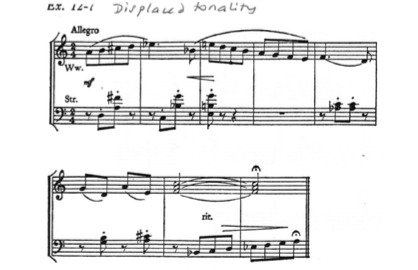
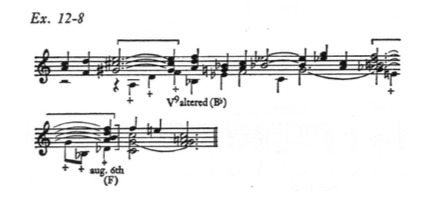
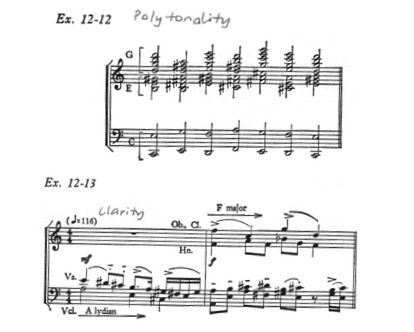
SERIAL HARMONY
The choice of notes in Serial Harmony are either dependent on the row (Total Organization) or include endless possibilities if the method of serial composition is less strict.
Intervallic relationships: consonances and dissonances are important factors in deciding how verticals are formed.
Melodic direction, voice-leading and texture also determine the overall effect of sonorities.
Motivic/ thematic features support cohesion and comprehensibility.
Rhythmic features and articulation are prominent characteristics.
examples of serial harmony;
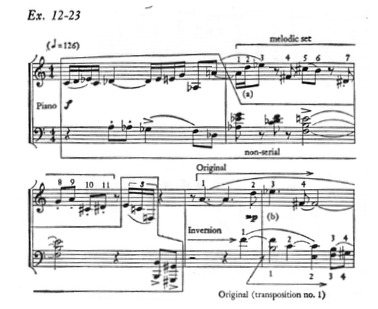
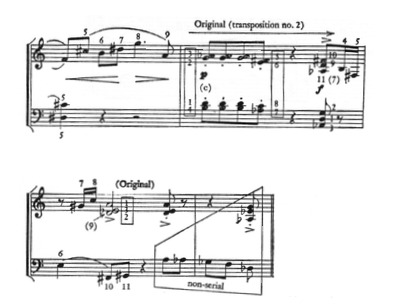

NEOTONALITY
Tonality that is not based on any particular diatonic system nor functional harmony (Common Practice Period)
Features non-traditional concepts such as tonal assertion or contrapuntal movement around a tonal centre (which may shift).
Combining the features of Common Practice Period tonality with 20th Century tonal ambiguity and atonal characteristics
Neotonal Composers
Stravinsky
Bartok
Kodaly
Janacek (maleva likes him)
Vaughn Williams
Prokovief
Shostakovich
Hindemith (maleva likes him too)
Samuel Barber
Villa-Lobos
Ginastera
William Schuman (MALEVA’S FAVORITE)
Roy Harris
William Walton
personal note:
on my personal note, i listen to these composers during my free time. and i found my pieces that really interest me. Some even has become my own personal “temp track” for my recital pieces! for example; Janacek’s “The Cunning Little Vixen: II. Allegro” was my inspiration when writing my piece “Purple-Pinkish Cotton Candy Sky” and “Full Moon”. Other than Janacek, I also took great inspiration from pieces from William Schuman, and others! Don't believe me?? Look at my SPOTIFY PLAYLIST!!! i legitly made playlists for each of the pieces that i want to write. I collect pieces that inspires me the most and built my creativity based on that.
maleva’s playlists for “Purple Pinkish Cotton Candy Sky”;
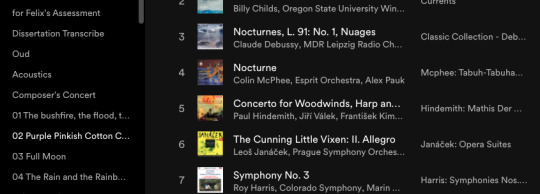
maleva’s playlists for “Full Moon”
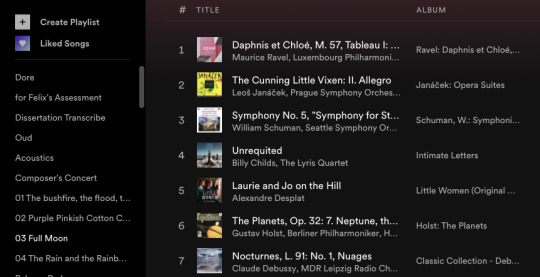
BACK TO THE LESSON;
at the end of the class, Belinda finalised the instruments that we will be having for our recital and remind us again regarding some checklists.
—————————————————————————————
WEEK 10 || Monday, 22nd of March 2021
This week’s class was so interesting, as we dissected the piece of our own BELINDA titled JOB
Topics:
Deconstructing JOB — A Symphonic Dance
Thinking timbrally
JOB — A SYMPHONIC DANCE
form
narrative driven
Dance form
“Through-composed”
Thematic thread
sections in order;
Parade of the Celestials
Gigue of the Adversary
The Challenge
Sabean Attack
Chaldean Attack
The Wind-Collapse-The Sores-Job’s Wife’s Curse
Sitting in Silence
Duet (Dialogue 1)
Dialogue2
Dialogue 3
The Whirlwind
My Eyes Sees Thee
Repent and Retract
Coda-Allegretto
THINKING TIMBRALLY
Wind Quintet & String Quartet configurations
Woodwind
Individual characteristics-flutey, reedy, hollow
Combines timbres
Dove-tailing
Spacing
Register and Dynamics
Harmonic balance
Unison and Doublings
Strings
Individual characteristics
Spacing
Harmonic balance
Register and Dynamics
Unison and Doublings
Combinations
Timbral combinations
Oboe & Cello
Bassoon & Cello
Flute and French Horn
Solo Wind with Strings
Solo Strings with Wind Ensemble
Contrapuntal, mul-timbral applications
Textures: harmonic textures, contrapuntal streams
Percussion & Miscellaneous
Definite and Indefinite pitch writing
Accents, shimmer, highlights, weight
As a features instrument
Orchestration Principles
Balance: feature, main, secondary...
Dynamic and emotional contour
Clarity
Span, register
Weight, Float
Interest
Momentum
Readability
—————————————————————————————
WEEK 11 || Monday, 29th of March 2021
Topics:
Review Form
Analyze Stravinsky’s Babel
Analyze Schwanter’s Aftertones of Infinity
FORM
Binary Form: A B
Ternary Form: A1 B A2
Sonata Form;
Exposition: 1st Subject/ Transition/ 2nd Subject/ Codetta
Development
Recapitulation: 1st Subject/ Transition/ 2nd Subject/ Coda
Simple Rondo Form: A1 B A2 C A3
Rondo-Sonata Form
Exposition: 1st Subject/ Transition/ 2nd Subject/ 1st Subject
Development
Recapitulation: 1st Subject/ Transition/ 2nd Subject/ 1st Subject/ Coda
Theme and Variation: featuring a main theme followed by altered iterations
Passacaglia: A series of variations over a basso ostinato
STRAVINSKY — BABEL
texture and density
Ostinato
Verticals
Chorale treatment
Narrative-Form
Momentum and Motion
SCHWANTER — AFTERTONES OF INFINITY
** i think this piece is amazing. Belinda also mentioned that this piece won a Nobel prize! there were a few things to take note of like;
Shimmering musical timbres
Layers of Sound
Protoset: C#-A-F-Gb-C-B-Ab-Eb-D
Predominant intervals
can be watched from here;
https://www.youtube.com/watch?v=Sns6KLvrb_o
—————————————————————————————
WEEK 12 || Monday, 5th of April 2021
Topics:
Review Compositional Devices
Analyze Toru Takemitsu’s A Flock Descends into a Pentogonal Garden
COMPOSITIONAL DEVICES
Common Practice Tonal Centers- Major and Minor
Chord Extensions- 9ths, 11ths, 13ths and alterations
Added note chords
Chromaticism and Tonal Ambiguity
Meter- Mixed and Asymmetric Meter
Modes and other Scale sources, including Synthetic scales
Polyharmony- polytonality and polychords
Non-tertian Harmony- Quartal and Quintal
Secundal Chords- clusters
Parallelism
12-tone Technique and Serialism
Limited Composition- based on intervals
Hexachord Writing
Unrelated Triads
Mirror Writing
Harmonic Direction- progression, cadential devices
Harmonic Synthesis
Indeterminate Procedures
Noise, Sound & Electronic devices
Extended Techniques
Texture
Microtones
TORU TAKEMITSU
Belinda mentioned how amazing that Takemitsu — although his music is very modern, but he would always never lose his Japanese touches in his music. Belinda also mentioned us about the importance of having a signature sound in our music. And it’s good if we can feature our own identity like where we come from for example.
Takemitsu’s music:
Straddled “parallel music cultures.”
Bi-musicality in modern Japanese culture: mixture of Western music with traditional Japanese music
In this piece, he uses the pentatonic scale (called the yo scale in Japanese.)
TORU TAKEMITSU — A FLOCK DESCENDS INTO A PENTOGONAL GARDEN
Clustered verticals
Silvery glisses
Lyrical melodies
Metallic, bell-like textures
Pentatonic base: C#- Eb- F#- Ab- Bb
Belinda also showed us some examples of some Contemporary String Quartets pieces;
String Quartet No. 2, "musica instrumentalis": III. Double Triple Gigue Fugue- by Aaron Jay Kernis, performed by Jasper String Quartet
link: https://www.youtube.com/watch?v=Y1dxsWGrtzQ
String Quartet No. 1, Op. 8: IV. Fugue- by Alan Hovhaness, performed by Shanghai Quartet
link: https://www.youtube.com/watch?v=VTQmztjK_2g
Love letters for String Quartet by Carter Pann, performed by Ying Quartet
link: https://www.youtube.com/watch?v=ER0faKEz0Ss
my personal note;
The “Love Letters” by Carter Pann was my personal favorite and i even listened back to it after the class ended.
—————————————————————————————
WEEK 13 to WEEK 16
throughout these weeks we had no more lessons but more consultation for our final recital.
0 notes
Text




DAY 5 (Entry - 3)
Friday, March 1st 2019
LAST BUT NOT LEAST.....
A GROUP PHOTO!!!
0 notes
Text
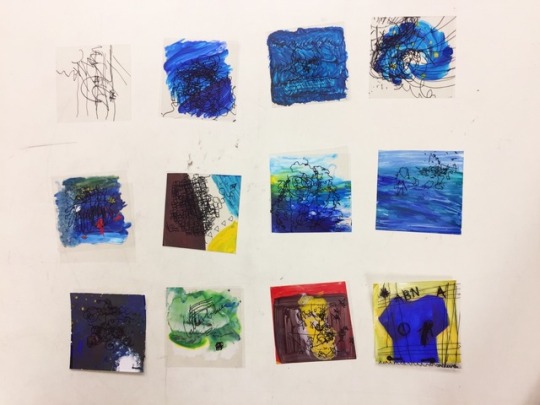
DAY 5 (Entry - 2)
Friday, March 1st 2019
FINAL RESULTSSS!!!! YAAYYY!!!!!
so we overlaid the result from the 2nd test on the 1st test and honestly, it is very wonderful to see how various it could be, and we are happy!
0 notes
Text
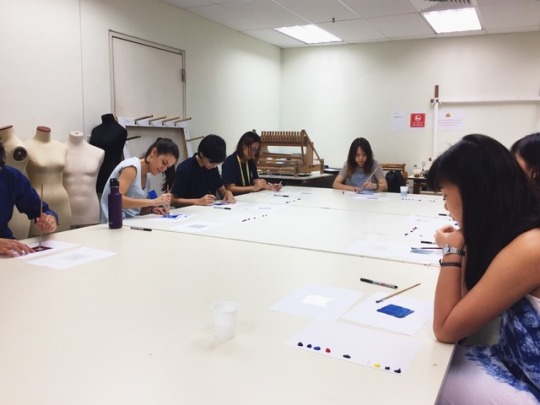

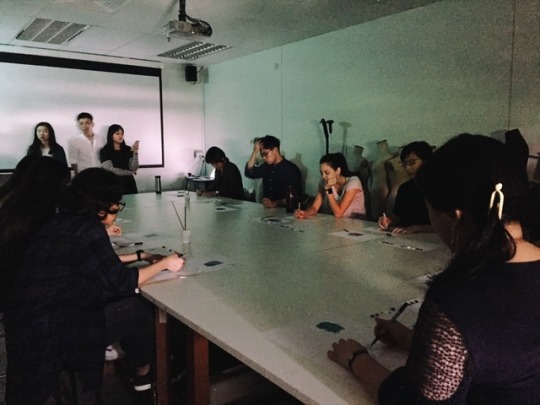
DAY 5 (Entry - 1)
Friday, March 1st 2019
test on going!
1st and 2nd photo
1st Test. “Paint what you feel about blue”
3rd photo
2nd Test. *Listens to music* “Think about a memory, let the music flows..let your mark flows with both”
0 notes
Photo
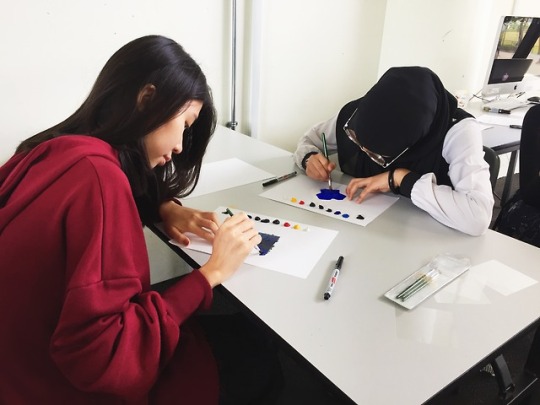
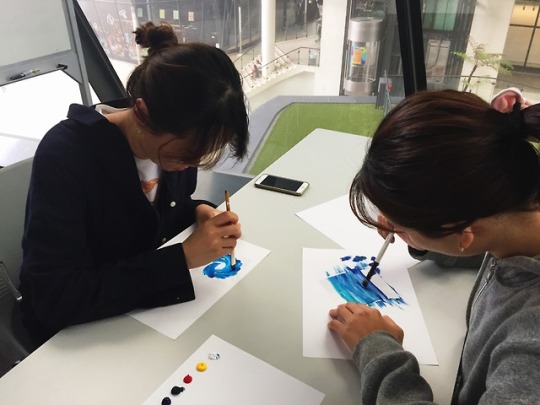
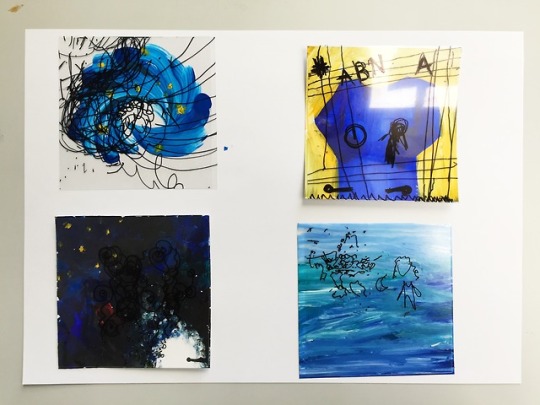
DAY 4 (Entry - 1)
Thursday, February 28th 2019
TEST - RUN 4 (Test 1 & 2)
For this particular test, we tested it out on people outside of our group to see if the exercise will carry out its objective. Anastasia brought 4 of her friends from Interior Design.
Following the steps we did from test 4 we conducted it the same way.
Conclusion (¾ effective)
The environment the participants were in wasn’t completely ideal
Instructions were not that clear
Overall quite effective as the results were quite interesting
we are continuing to improve by tweaking our instructions.
0 notes
Text
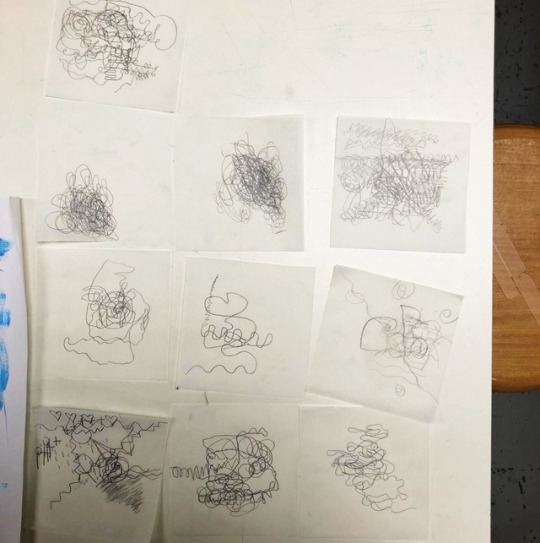
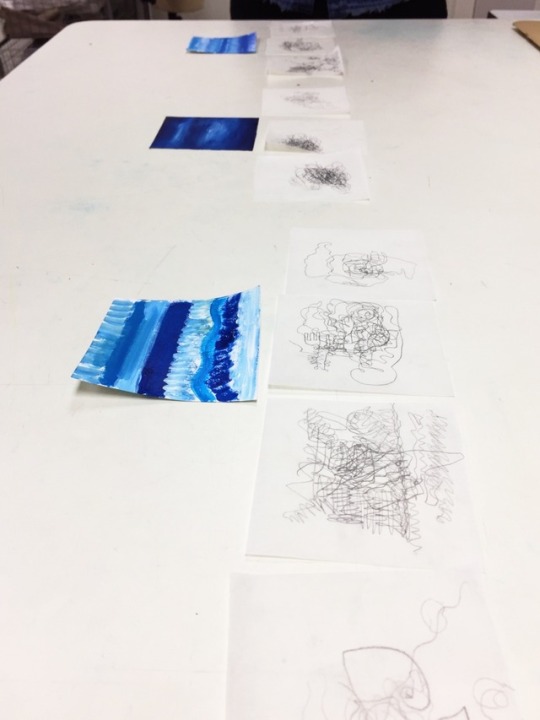
DAY 3 (Entry - 3)
Wednesday, February 27th 2019
TRIAL 3
Same as the previous tests, we had to close our eyes while the audio was being played but what was different this time is that
We could lift up our pens while drawing
We were prompted with questions from the start so that we already had a memory in mind
The audio that was being played is now changed to something more generic common noises that people have heard/experienced before and we also added sound effects (noise of the ocean, noise of the wind)
Conclusion (effective)
The aim and objective of the whole exercise of wanting to use audio to trigger certain emotions and memories was met.
0 notes
Text
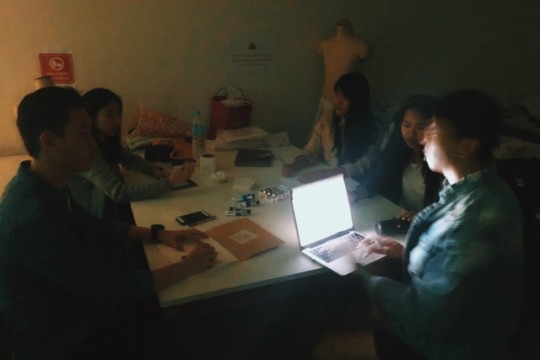
DAY 3 (Entry - 2)
Wednesday, February 27th 2019
TRIAL 2
Drawing in the dark with eyes closed while listening to songs. This, we believe will change their perception of their ‘blue’ memories.
Objective: To use the audio and trigger certain emotions and memories we have of “blue”
Test ‘2′:
We closed our eyes while the audio is being played to ensure that we are focused on our thoughts and not distracted by our surrounding
No prompts (questions) were given. Just the music was being played.
We could not lift up our pens while we were drawing
Conclusion (not very effective)
Cannot relate to the song, therefore end up just drawing according to the song’s tempo, rhythm
Did not trigger any emotion/memories
Improvements for Test ‘2′
There were questions that prompted us to think of a certain memory that is related to blue
The audio was changed to something more generic (noise)
Pen can be lifted up when drawing
1 note
·
View note
Text


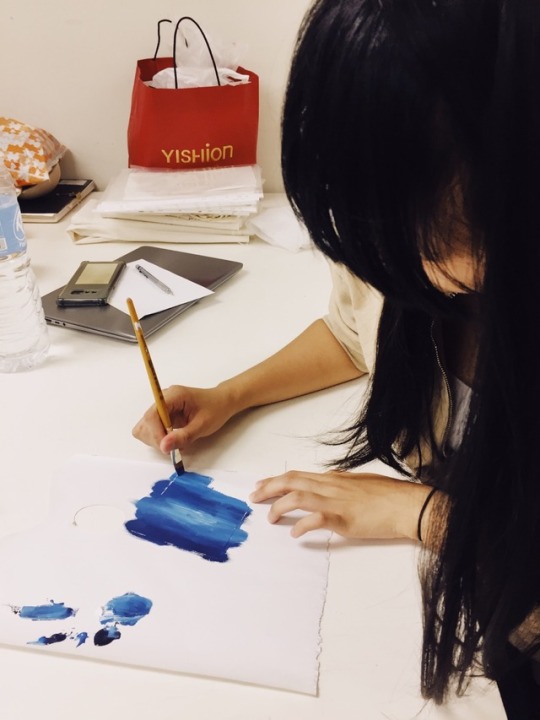
DAY 3 (Entry - 3)
Wednesday, February 27th
—
TRIAL 1 (Test 1)
Objective: To transfer our feelings towards blue into visuals
1. We were told to mix our own set of colours
2. We were asked to oaint what we felt about blue
Conclusion (not very effective)
1. Did not have anything in mind
2. More focused on mixing the colours
Improvements:
1. Colours will be prepared beforehand as the mixing the colors was distracting
2. Added more color options as some might feel that their feelings of blue might not specifically be blue in colour whereas it can be expressed with other colours
“paint out your thoughts about blue”
Here was Ryan’s thought!
1 note
·
View note
Text
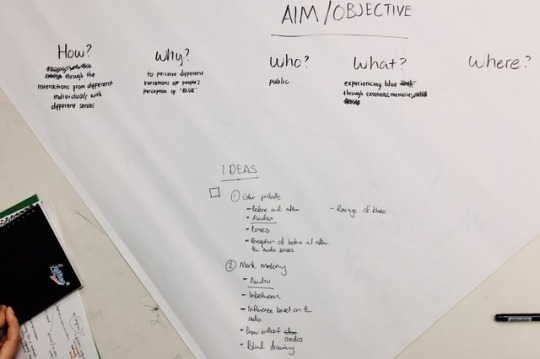
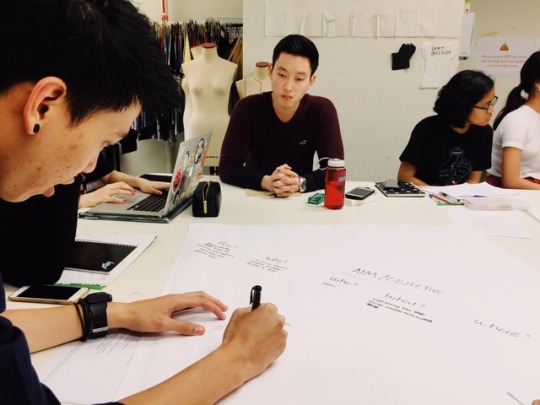
DAY 2 (Entry - 2)
Tuesday, February 26th 2019
We narrowed down our ideas from the paper we made the day before and we discussed about what we’re gonna do for our project.
SO! To made everything clear for us and understandable for our lecturer (Chris from Interior Design), we pointed out our ‘WHAT/WHO/WHERE/WHEN/WHY/HOW’
WHAT
• Experience blue through emotions & memories
WHEN
• Last day of IP! (Friday)
WHERE
• Tentative
WHO
• Public! We want basically anyone, any age, any race, any gender!
WHY
• We are doing this because we want to perceive different variations of people’s perception about blue
HOW
So it’s going to be two rounds
• 1st — we will ask those who come, to paint about their perception about blue with the provided blue pallete. Their drawings could be anything. Eg; when i think of blue, i think of sadness and loneliness (emotion), therefore i’m gonna paint something minimalist (lonely) stuff on the canvas with dark blue paint (sadness, dark).
• 2nd — we will ask them to paint again, but this time round they will be painting with eyes closed (blindfolded) while listening to a piece (audio). Therefore, the audio will change their thoughts about blue because what they listened, we believe can bring back certain memories.
All those paintings at the end will be collaged together, and that will be our artwork.
1 note
·
View note
Text

DAY 2 (Entry - 1)
Tuesday, February 26th 2019
Wearing blue again for the 2nd day of Interdisciplinary Project! Plus! Matching it with my shaker hahahahha! (Well, not really cos it’s actually in purple..but..close enough!)
1 note
·
View note
Text
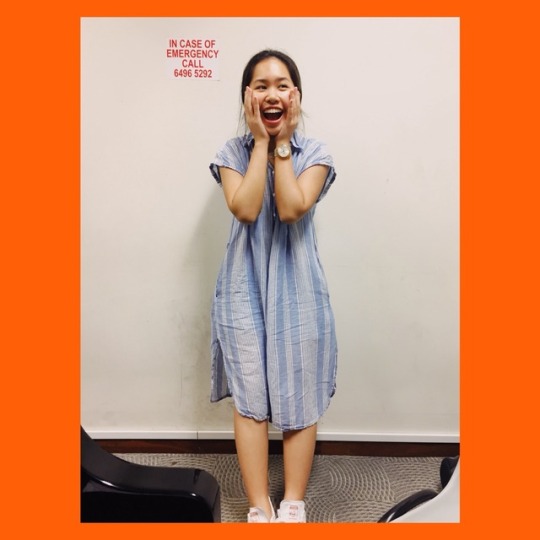
DAY 1 (Entry - 3) LAST THING!
Monday, February 25th 2019
I wore blue for the first day of BLUE themed Interdisciplinary Project!
1 note
·
View note
Text

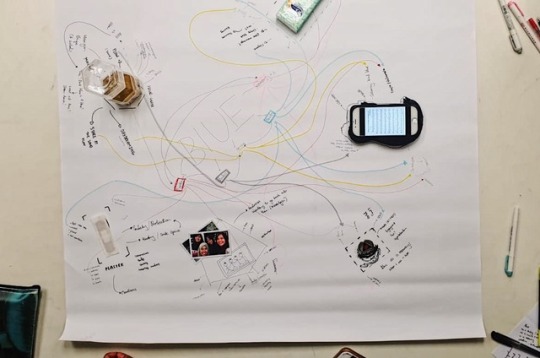
DAY 1 (Entry - 2)
Monday, February 25th 2019
1st Photo — our little group photo! Consisting me (Music), Anastasia (Interior Design), Ryan (Product Design), Joey (Fine Arts), Jun Kiat and Angela (Design Communication) 😆
2nd Photo — our scribble a.k mindmap(?) of our perception about ‘blue’ based on the stuffs we brought. (earlier on, our lecturer told us to bring an object about BLUE, but not BLUE in colour)
2 notes
·
View notes
Text

DAY 1 (Entry - 1)
Monday, February 25th 2019
Light and the Spectrum.
3 notes
·
View notes